List of flags of the German Navy (1935–1945)
This article shows a list of flags of the German Navy, which includes flags, standards and pennants that used in the years between 1935 and 1945 by the German Kriegsmarine and merchant navy.
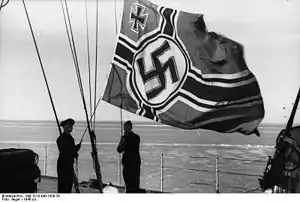
National and merchant flag
| Flag | Date | Designation | Description |
|---|---|---|---|
.svg.png.webp) | 1935–1945 | National and merchant flag, and Marine jack | The width ratios of red area: circular disk: red area behaved as 9: 18: 13. At sea was used since 1933 exclusively and prescribed the version with the inwardly offset swastika. |
Merchant flag with the Iron Cross
| Flag | Date | Designation | Description |
|---|---|---|---|
 | 1935–1945 | Merchant flag with the Iron Cross | Used by merchant navy captains who were retired Navy officers (reserve officers) |
Reichskriegsflagge
The Reichskriegsflagge, which was introduced on 7 November 1935, was widely used in the Wehrmacht. Thus, it also served the Kriegsmarine as the naval ensign, which was hoisted on Flag days regardless of the location of the ship. These were 1 January (New year), 18 January (founding day of the German Empire in 1871), 30 January ("day of national survey"), 20 April (Adolf Hitler's birthday), 1 May ("Labor Day") and 31 May (anniversary of the World War I Battle of Jutland). In addition, ships in home waters had to hoist the Reichskriegsflagge on 1 March (commemorating the 1935 reintegration of the Territory of the Saar Basin into Germany), 29 August (the day of the founding of the Prussian Navy in 1859), the first Sunday after Michaelmas and the day of the Harvest festival. Regardless of these days, all warships that received a head of state were obliged to show the Reichskriegsflagge.
| Flag | Date | Designation | Description |
|---|---|---|---|
.svg.png.webp) | 1935–1937 | Reichskriegsflagge | Introduced on 7 November 1935 |
.svg.png.webp) | 1938–1945 | Reichskriegsflagge | The width and the course of the black stripes were changed compared to the previous version. This change was likely made in December 1937, but there are no official publications about it. |
Reich service flag
The Reich service flag was used by all state authorities, such as the Reichsbahn, Reichsautobahn and Reichsbank. In the navy, the Reich service flag was carried by all state-owned vessels that were not allowed to hoist the Reichskriegsflagge. In the case of the absence of the Reich service flag, the national and merchant flag had to be flown in its place.
| Flag | Date | Designation | Description |
|---|---|---|---|
 | 1935–1945 | Reich service flag | The flag had the proportions of 3 : 5. There was an upstanding swastika in the centre, on a white circle with a black boarder. A Reichsadler is placed in the upper hoist. |
Flags of the Kriegsmarine
Most command and rank flags of the German navy had traditional character and were already used in the Imperial and before the Prussian Navy. The flag of a Grand Admiral was very similar to the version used in the Imperial Navy. Completely new, however, was the rank of General Admiral, which Erich Raeder, the Commander in Chief of the Kriegsmarine, adopted in 1936. In order to avoid Raeder having a higher rank than the Commander-in-Chief of the Luftwaffe (Colonel General Hermann Goering) and the Army (Generaloberst Werner von Fritsch), the rank of General Admiral was introduced. The actual intended rank of a Grand Admiral as Commander-in-Chief of the Navy was "postponed" and a special flag introduced for a commander-in-chief who is not Grand Admiral. Raeder was promoted to Grand Admiral in 1939, meaning the special flag was still official, but found no use. This continued with the successor of Raeder, Karl Doenitz, who in 1943, was promoted from the rank of Admiral to General Admiral, skipping General Admiral.[2]
Higher command rank flags
| Flag | Date | Designation | Description |
|---|---|---|---|
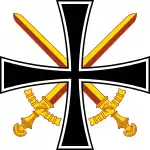 |
1935–1945 (de facto until 1939) |
Flag of the Commander-in-Chief of the Navy, if not a Grand Admiral | Two crossed Admiral swords on which the Admiral cross is placed. |
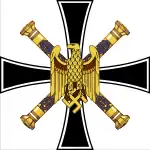 | 1939–1945 | Grand Admiral's Flag | Arranged on an Admiral cross two crossed Großadmiral batons and the Wehrmacht eagle in yellow. Striking is the "shading technique" used in this flag. Both the Grand Admiral Staff and the Wehrmacht eagle were equipped with shadow elements. |
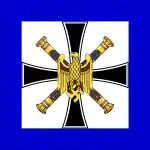 |
1943–1945 | Flag of the Inspector Admiral of the Navy of the Greater German Reich with the Rank of Grand Admiral | Flag of a Grand Admiral with a wide light blue border which was one fifth of the width of the inner flag. The position of Admiral Inspector was held by Erich Raeder. |
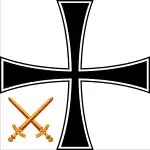 |
1935–1945 | General Admiral's Flag | An Admiral cross with two crossed swords in yellow and brown in the lower hoist |
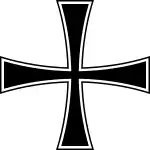 |
1935–1945 | Admiral's Flag | The Admiral Cross was already introduced in the Prussian Navy |
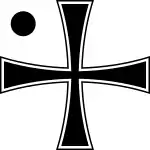 |
1935–1945 | Vice Admiral's Flag | An Admiral cross with a black ball in the upper hoist. |
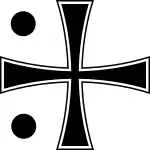 |
1935–1945 | Rear Admiral's Flag | An Admiral cross with black balls in the upper and lower hoists. |
Other command flags
| Flag | Date | Designation | Description |
|---|---|---|---|
 | 1935–1945 | Commodore pennant | The pennant raked in the topmast was cut to 60% of the total length. |
 | 1935–1945 | Seniority pennant | Like the Commodore pennant but hoisted on the Yard. |
 | 1935–1945 | Leader pennant | Like Kommodorestander, but freely swinging. |
 | 1935–1945 | Flotilla pennant | Hoisted in the top mast |
 | 1935–1945 | Group pennant | Like the Flotilla pennant but hoisted on the Yard. |
| 1935–1945 | Command pennant | The pennant was cut in a quarter of the total length and had a height-to-length ratio of 15 : 1000 |
Vehicle flags and pennants
| Flag | Date | Designation | Description |
|---|---|---|---|
 | 1940–1945 | Vehicle pennant for Admirals as a land troop commander | All pennants and flags had a length-to-height ratio of 5 : 3 |
 | 1940–1945 | Vehicle pennant for sea commanders and Brigade Commander of the Kriegsmarine | |
 | 1940–1943 | Vehicle pennant for department commanders of the Kriegsmarine | |
 | 1943–1945 | Vehicle pennant for department commanders of the Kriegsmarine | The yellow, clear anchor was added on 20 January 1943 |
 | 1940–1943 | Vehicle pennant for Navy Fortress Commanders in Staff Officer Positions and Navy Regimental Commanders | |
 | 1943–1945 | Vehicle pennant for Navy Fortress Commanders in Staff Officer Positions and Navy Regimental Commanders | The yellow, clear anchor was added on 20 January 1943 |
 | 1940–1945 | Car Pennant for Admirals | The pennant had a width of 35 cm and a height of 23 cm. The golden border, decorated with a total of 42 swastikas, had a width between 25 and 30 mm. The Reichsadler was of yellow color. |
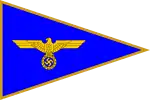 | 1940–1945 | Car Pennant for Other Members of the Navy | The pennant had a width of 33 cm at a height of 22 cm. The golden edge had a width of 6 mm. The Reichsadler was of yellow color |
War Merit pennants
| Flag | Date | Designation | Description |
|---|---|---|---|
 | 1941–1945 | War Merit Pennant[3] | Awarded to captains of vessels not sailing under the Reichskriegsflagge for "extraordinary merit in warfare". |
 | 1943–1945 | Swallowtailed Pennant for the Destruction of Enemy Ships by the Coastal Defence | Awarded to Coastal Defence units for the destruction of cruisers and above |
 | 1943–1945 | Pennant for the Destruction of Ships by the Coastal Defence | Awarded to Coastal Defence units for the destruction of destroyers and below |
 | 1940–1945 | Pennant for the Downing of Enemy Aircraft | Awarded to the responsible unit for downing of enemy aircraft (one for each aircraft) by anti-aircraft batteries or light anti-aircraft weapons |
Flag for Landwehr Kriegsmarine units
| Flag | Date | Designation | Description |
|---|---|---|---|
 | 1936–1945 | Flag for land-based troop units or installations of the German Navy (left side) | Introduced on 8 September 1936. As prescribed for all flags of the Wehrmacht, the dimensions of the flag were 126 by 126 cm. It was attached to a 3 meter long flagpole |
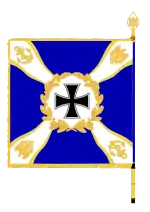 | 1936–1945 | Flag for land-based troop units or installations of the German Navy (right side) | Same as above |
Other naval flags
| Flag | Date | Designation | Description |
|---|---|---|---|
 | 1935–1936 | Water Sports Flag | The black-white-red flag with a white, 45 degree twisted anchor on the black stripe. Used from 31 May 1935 to 17 January 1936. |
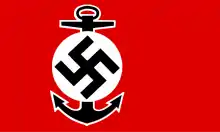 | 1936–1945 | Water Sports Flag | On a black, white-lined, clear anchor placed a white disc with the swastika. Adopted on 6 April 1936 |
 | 1935–1945 | Pilot Flag | Flag of the pilot vehicles and pilot signal. The height or width of the white stripe was one fifth of the height of the inner flag |
 | 1935–1945 | Identification mark of the Weserlotsen vehicles | Placed in the topmast and indicated that the pilot vehicle has ready-to-use pilots on board. The size ratios of the flag were 5: 9 |
 | 1936–1945 | Postal Navy Flag | Introduced on 14 March 1936 |
Flags for special occasions
| Flag | Date | Designation | Description |
|---|---|---|---|
.svg.png.webp) | 1935–1945 | Black-white-red Imperial War Ensign | Hoisted on commemoration days on special orders. |
.svg.png.webp) | 1935–1945 | Imperial War Ensign | Hoisted as a flag on every 31st of May (remembrance of the Battle of Jutland) |
 | 1940–1945 | Austro-Hungarian war flag | Raised as a flag on the heavy cruiser Prinz Eugen in place of the Imperial War Ensign on every 31st May |
See also
References
- Busch & Röll 2003, p. 28.
- "Award pennants of the Kriegsmarine". Flags of the world. 11 November 2017. Retrieved 5 December 2018.
Literatures
- Angolia, John R.; Schlicht, Adolf (1993). Die Kriegsmarine - Uniforms & Traditions 3 Volume. R. James Bender Publication. ISBN 9780912138459.
- Busch, Rainer; Röll, Hans-Joachim (2003). Der U-Boot-Krieg 1939–1945 — Die Ritterkreuzträger der U-Boot-Waffe von September 1939 bis Mai 1945 [The U-Boat War 1939–1945 — The Knight's Cross Bearers of the U-Boat Force from September 1939 to May 1945] (in German). Hamburg, Berlin, Bonn Germany: Verlag E.S. Mittler & Sohn. ISBN 978-3-8132-0515-2.CS1 maint: ref=harv (link)
- Davis, Brian Leigh (1984). Flags & standards of the Third Reich: Army, navy, & air force, 1933-1945. Arco Pub. ISBN 978-0668036207.
- Oberkommando der Kriegsmarine (1992). Das große Flaggenbuch (in German). Mauritius Buch Verlag. ISBN 978-3980334204.